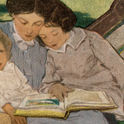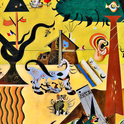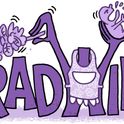Denmark’s most successful recent export, hygge, is difficult to translate into English—perhaps “cosiness” is the closest fit. For Danes, hygge evokes feelings of contentment, warmth and conviviality: think wood-burning stoves, knitwear, candlelight, artisanal blankets draped over a stylish sofa, and the smell of baking rye bread wafting from the kitchen. Hygge has long been important to Danish culture, but perhaps it is no surprise that many of us find this inviting fireside aesthetic especially appealing in uncertain times.
By contrast, the 19th-century philosopher Søren Kierkegaard—another famous Danish export—regarded this penchant for cosiness as pathological. Kierkegaard lived all his life in Copenhagen, where he diagnosed a spiritual complacency masking the anxiety and despair which, he argued, all human beings experience. Like almost all his fellow Danes, Kierkegaard was baptised in the Lutheran Church; during the 1840s and 1850s writings poured from his pen, challenging its teachings while also seeking a more authentic form of religious life.
Kierkegaard modelled his philosophical style on Socrates, the eccentric philosopher of ancient Athens. Socrates went around asking difficult questions. What is courage? What is justice? After conversing with Socrates, people who thought they knew the answers to these questions were left confused. He compared himself to a gadfly sent by the gods: “I go about arousing, and urging and reproaching each one of you… But you, perhaps, might be angry, like people awakened from a nap, and might slap me, and easily kill me; then you would pass the rest of your lives in slumber, unless God, in his care for you, should send someone else to sting you.” Socrates made such a nuisance of himself that he was indeed condemned to death, for the crime of “irreverence.”
Inspired by this example, Kierkegaard sought to provoke and unsettle in inventive, challenging works such as Fear and Trembling, The Concept of Anxiety, and The Sickness Unto Death. He lived through a period of intense social change: new technologies such as railways, telegraphs and mass printing were making everyday life easier, at least for affluent people like himself. He thought spiritual life had also become too comfortable. Christianity was such a settled part of 19th-century culture that for many Christians it meant little more than conforming to bourgeois family values. Kierkegaard emphasised the religion’s counter-cultural origins: Jesus, like Socrates, was an unconventional, disruptive figure who was eventually executed for his provocations.
Kierkegaard’s message went beyond Christianity: above all, he was interested in the human condition, and his insights have touched generations of readers, of all faiths and none. He encouraged people to confront suffering, instead of avoiding it. This was not because he celebrated misery, but because he believed that true peace and joy come from the depths of the human heart, which can be reached only by contending with life’s uncertainties.
Ironically Kierkegaard’s suggestion that everyone suffers from anxiety and despair can be curiously comforting. In The Sickness Unto Death he wrote that: “Just as a physician might say that there very likely is not one single living human being who is completely healthy, so anyone who really knows mankind might say that there is not one single living human being who does not despair a little, who does not secretly harbour an unrest, an inner strife, a disharmony, an anxiety about an unknown something or something he does not even dare to try to know.”
As the steady stream of new self-help literature on sleep suggests, human beings struggle to rest even when they are fortunate enough to have comfortable beds. Kierkegaard was a terrible insomniac, and habitually worked late into the night; during the day, he walked and talked his way around Copenhagen for hours at a time, fuelled by alarming quantities of strong, sugary coffee. These restless habits, which probably killed him, were symptomatic of a longing for spiritual sustenance, a passion for truth, an urgent search for an elusive God. Though this kind of existential restlessness can be very uncomfortable, Kierkegaard saw it as a vital sign of life. It often lies buried beneath more material aspirations and distractions, making its presence felt obliquely in the experience of anxiety, which we usually try to rush away from. Yet it is in this restlessness that we are most fully human: curious, questioning, searching, moving, growing.
Kierkegaard’s works are not easy to read, and his spiritual restlessness is not easy to accept. It is not supposed to be. Nevertheless, while the more soothing Danish voices of his century have long since faded into oblivion, Kierkegaard remains an anti-hygge hero. Through his eyes, we can look afresh at our own desire for comfort. Of course we want to feel cosy and secure: it is difficult to be human, and deep down we might not be sure who we are, where we are, why we are. Let’s gather round the fire by all means: those glowing, ever-changing flames hold questions for us all.














